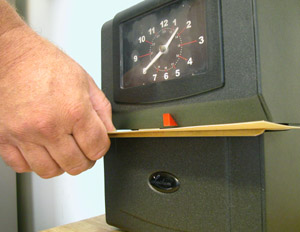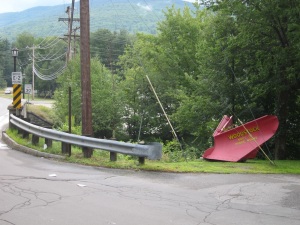I needed to put something in something and carry it somewhere. Genius was not required to conclude that a bag was what I needed.

In a deep, tall closet that we use as a kitchen pantry, there is a certain shelf – when this building was home to a contractor’s office, before we turned it into a home, this closet was utilized to store boxes of files, so the shelves are sturdy and broad – and about half of this shelf is inhabited by our stockpile of paper bags. [Digression: Don’t use plastic – save the Earth. End of diatribe.] There are, on this shelf, grocery bags of all sorts – the plain brown sacks, the ones with formed paper handles, the ones that have been made deceptively smaller (as if we didn’t notice) so that it seems as if your huge supermarket bill has bought you more stuff when in fact it has bought you less, the ones that have stamped on them the alleged name of the possibly fictitious line worker who, “with pride,” pushed the button to the bag-cutting and -forming machine. (And just why do the markets and paper companies think that we’re interested in knowing who made this bag that, “with pride,” is already about to burst at the bottom with the weight of three boxes of tissues in it? Are we supposed to feel good about the bag because “Fernando Torres” had a hand in its mechanical manufacture? Is the personalization meaningful, even to Fernando? Are we to think that the bag was handcrafted in some way by an artisan who, apparently, likes to work in multiples? Is the point of the worker’s name on the bag so that we know to whom to direct our “Great bag – keep up the good work” thank-you note? I don’t get it, but to save a stamp, let me state here publicly: “Thanks, Fernando Torres, for helping me get my tofu home safely. Stay proud, but don’t get cocky.”)

Most of the bags on the shelf come from supermarkets, a few from department stores (remember them? They used to advertise in all the newspapers. Remember them?). A few of the bags have the logos of high-end boutiques (the only way they got here is if somebody else used them to bring us gifts). There are thin and long bags that once had wine bottles slipped into them. There are bags that seem masculine; others that seem feminine. And others that, like kids in school who don’t know the answer to the teacher’s question, are scrunched back so that they won’t be selected. Some bags we’ve had for just a week or two, while there are a few goofballs or underachievers that we’ve probably had for years.
And then there is a clump of them, a real handful, maybe 50 or so, tied together by the kind of white string that bakeries bind their boxes with. They’re crisp, brown, Duro No. 6’s. I look at them, and it’s funny the things that make memories rise up in front of your eyes, spectrally, faster than light speed, but these bags do it for me. They are, sitting there, themselves placeness, and, via recall, placeness suggesters. First, they make me think of – and feel, and smell, and hear, and, strangely and sadly, turn around and swear that for a second I can even see – our guys, that special and irreplaceable litter of cats, now long-gone but forever clawing at the fabric of our hearts … because we would use a new one of these bags just about every day to hold the nasty stuff we’d scoop from their litter boxes. The Duro No. 6 size seemed just perfect: It could hold a lot, but not too much, because you wouldn’t want a big bag of cat stools sitting around for very long or bursting open at the seams, and the No. 6 was easy to lift when full, and its opening was big enough for a heaping scoop to slide in and out of without losing its toxic cargo. And when each was filled, it would be put into a grocery bag with a half dozen or more of its stinky brethren, to sit until trash day, a pile that looked like a fraternity prank in the offing.
But, then, a second memory intrudes on the first. It is of a store, a really old place on a corner in an ancient part of town which has seen gentrification and upscaling but it, the store, resisted until recently all attempts to ride the coattails to the present, or even the near past. The building is more than 150 years old, and the store in it – a restaurant- and party-supply business – looked to have stock that went back nearly as long. And employees older than that. We called it “the wet dog store” because it smelled like … well, there, you got it. The floors of the place were original and wood that was in spots concave from the generations that trod on it; the shelves were loaded with items that would be archaic if they weren’t, now, suddenly, in the forefront of retro, everything an eatery or food truck might need, if it wasn’t too fancy and the year was 1953: cardboard boats to hold hotdogs, the kind of blue-and-white Anthora paper coffee cups that look like they’ve been around since the ancient Greeks, all kinds of wood coffee stirrers and french-fry pokers, Chinese takeout boxes, classic mustard and ketchup squeeze bottles and sugar pourers … and bags. Paper bags. Tons of them: the kind that corner stores scoop candies into, the kind that pastry shops slip paper-wrapped eclairs into, the ones that perfectly encase a loaf of rye bread. Each type of bag sat, gathered in big fistfuls, tied in string, on old and dusty shelves, with no price anywhere to be found. You’d ask a clerk what a bundle of No. 6 bags cost, and he’d say that he’d have to ask the owner, who sat in an office tucked back in the store and who may have been dozing back there since the building’s foundation was poured. The owner would shuffle out, take a look at the item, take a look at you, size you both up, make a face briefly that led you to believe that he was trying to remember the price, and then would make it up. “Three dollars,” he’d say, definitively and arbitrarily, on one visit. “Two-fifty,” he’d quote you the next. Whatever, it was worth it – cheaper than the much more cheaply made similar bags they sell as sandwich bags in supermarkets, and, anyway, buying from this ancient guy in this ancient place was not only great urban theater, but it was personally becoming a part of a continuity that would not continue much longer. Stores like this are vanishing, with neither a whimper or bang, as older generations die and younger generations don’t want to continue in the business, or they don’t want this kind of stuff anymore, or they buy it now on Amazon or eBay. But these latter miss the point of the joy of commerce. Buying in a store like this is like being an actor in a play for which you have no script but you know all the lines, except that the central character keeps improvising. Even, sometimes, when the owner would make up too high a price – “Five,” he’d say, as if it had always been five – you paid it anyway, without a fuss or reminding him of what you had paid the previous visit, because you wanted to support this creaky vessel until that inevitable day when you’d come for your bags and there’s a Starbucks sitting there instead …
All of this, rushing at me, sparked by a bunch of bags in my pantry, where they create a placeness in my home and echo the placeness of their origin and their wonderfully circuitous journey to me, and my journey with them.
And, please, don’t get me started on the napkins and toothpicks – we could be here all day.

































